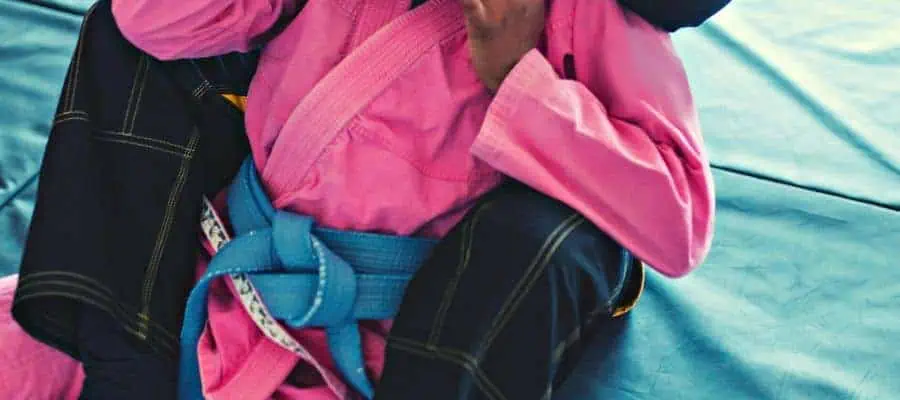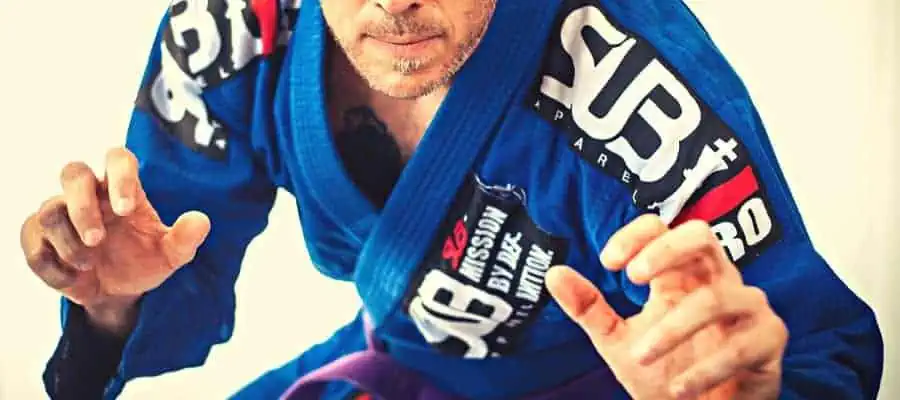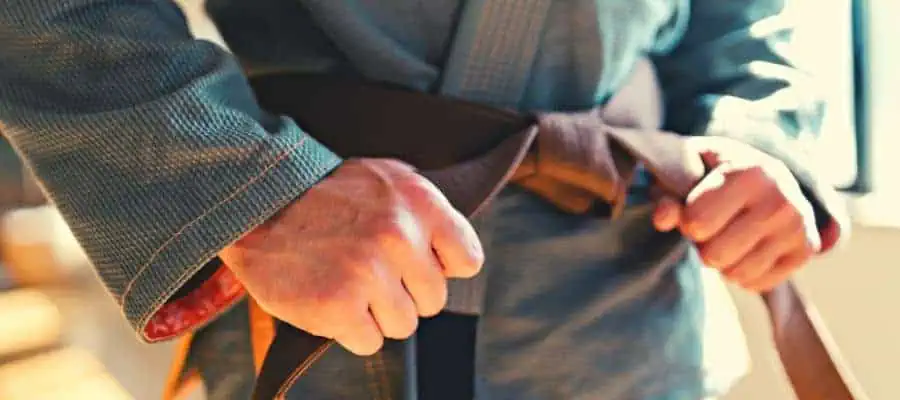One of the most asked questions about BJJ is “how long does it take to get a belt.” This is not a trend only among beginners. The Jiu-Jitsu world is full of stories. Some say that where there is no law, there is no rule. Usually, the exceptions are what build up more interest in people.
But this saying is not entirely true. Although there are exceptions, belt graduation usually follows a pattern. And, yes, there are rules. Breaking them has no significant practical consequences, but it’s frowned upon. This is not just a detail in a sport that is so hard to earn respect.
The IBJJF graduation system states that athletes’ graduation must meet minimum requirements. The following table shows how much time the adult athlete needs to hold a belt to get the next one:
| Belt | Average Time |
|---|---|
| White Belt | No Minimum Time |
| Blue Belt | 2 Years |
| Purple Belt | 1.5 Years |
| Brown Belt | 1 Year |
| Black Belt | 31 Years |
| Red & Black Belt | 7 Years |
| Red & White Belt | 10 Years |
| Red Belt | Undefined |
There are some exceptions to the same rulebook. But the same manual also states that the time taken to graduate the athlete from White Belt to Black Belt is at the professor’s (Black Belt instructors) discretion. However, IBJJF will only recognize the graduation if it meets the mandatory minimum times listed for each belt.
Even so, many of the most famous exceptions managed to become IBJJF at the very Belt that supposedly would not be recognized by the organization. If something like this happens in an organization, then it doesn’t matter much about the time it takes to get the belt.
But, as mentioned, patterns usually lead to respect. And this is why many instructors and professors will only graduate over a reasonable time.
How Long Does It Take To Get A Blue Belt?

The Blue Belt is the first graduation for many categories. The belt rank for athletes aged 16 years or older for most federations goes from white to red. After the White Belt comes the Blue Belt. There is no need for graduation to take the White Belt, so the first one is usually for the blue.
IBJJF suggests its use, but it’s not mandatory up to the Brown Belt. From Black Belt on, it becomes a rule. Usually, each belt has 4 degrees. These degrees are normally distributed equally over time for a belt. But there is no hard rule for that.
Having this information in mind, the time needed for the first graduation is totally at the professor’s discretion. But, on average, an athlete with no prior experience in a related Martial Art will take about two years to get a Blue Belt.
There are many technical similarities. A former Judo or Wrestling athlete can take just a few months to be graduated. The gap between a total beginner and a Blue Belt is enormous. But a grappler can translate much basic knowledge to make BJJ easier to learn and speed up the process.
This is especially true for Judo fighters. The Japanese Martial Art is considered to be the father of BJJ. So, it’s not the end of the world to think that a judoka may take a fast lane. An irregular athlete can take up to four years to reach the Blue Belt. It’s not rare to find people who take longer to achieve this same level. That depends on talent, for sure. But it’s mainly a matter of consistency.
However, we should not discard talent. The truth is that some people are just natural for BJJ. Those with no prior experience can also graduate in less than a year. This flexibility is essential in the White Belt, a period when technique learning means more than the experience itself.
How Long Does It Take To Get A Purple Belt?

From the Blue Belt on is when things get a kind of skeleton. According to the IBJJF rulebook, the minimum time of permanence in the Blue Belt is two years. The funny thing is that the average time for graduation is also two years.
Most athletes will be graduated from Blue Belt to Purple Belt in two years. It might be even less, although the rules forbid it. This happens because if an athlete has trained enough to reach a Blue Belt, he is probably consistent. More training means more evolution.
Some athletes cannot graduate from Blue Belt to Purple Belt in just two years, though. But usually, these are athletes who are injured or, for some reason, spend some time away from the “Tatami” (mat) than in training.
The Blue Belt is considered the moment the athlete gets more technical knowledge. This is when the experience starts to improve the pace of learning. Many Black Belts will state that the Blue Belt is the most important in BJJ.
How Long Does It Take To Get A Brown Belt?

An athlete’s permanence in the Purple Belt, according to the IBJJF manual, has to be at least one year and a half. The same rulebook presents some exceptions. If the athlete had been previously registered as a Blue Belt Juvenile, this time is reduced to one year.
If he was previously registered as a Green Belt or Orange Belt and Blue Belt Juvenile, there is no minimum requirement. The colors grey, yellow, orange, and green are specific to athletes under 16 years old. These exceptions are made to consider this transition period and the evolution during an athlete’s teenage years.
The average time to graduate from the Purple Belt to the Brown Belt is about one year and a half. Most athletes are graduated between one year and a half and two years. However, many athletes take the fast lane too. There are even a few cases of people who skipped the Brown Belt.
How Long Does It Take To Get A Black Belt?

The Black Belt is for sure a highlight. Some people aim higher, but this is unquestionable the most desired landmark. The time of permanence of an athlete in the Brown Belt, according to the IBJJF rulebook, shall not be less than one year.
The Black Belt is usually when the logic gets inverted. For most cases, the average time is lesser than the required by the IBJJF. But, on average, an athlete will be graduated from the Brown Belt to Black Belt in two years.
This happens for many reasons. The most common one is age. Unless an athlete has begun young, this is the stage when real-life problems start to slow him down.
For those who are professional fighters, this time is usually reduced. The obvious exception, though, is the injured athlete. This is also when injuries are more frequent for both age and intensity. So, overall, patience is essential for reaching the Black Belt.
Another critical factor is a mentality. There is a natural barrier that puts regular people apart from Black Belts. This is a highlight in anyone’s career. Saying you are a Brown Belt is not even close to saying you are a Black Belt. The stairs you must climb to reach this Pantheon shall not be underestimated.
For this reason, many teachers hold their students’ graduation for longer than required. For the following belts, the critical factor is time. You will eventually be promoted with a black belt if you prove you’ve been active during your Black Belt years. For this reason, there is no fast lane after the Black Belt.
The Biggest Exceptions To Black Belt

The average time to go from a beginner to a Black Belt is seven and a half years. If you analyze the IBJJF rulebook, the minimum time to get a Black Belt is four years and a half. It’s not rare to find people who took from 10 to 15 years for that. But having this desired belt around your waist can take much more.
This considering someone spent no time in the White Belt, which has no minimum permanence requirement. However, there is an average time, and it is usually respected. Also, there is a couple of noted exceptions to the rule. Some of them got their Black Belts even faster than the minimum period stated by IBBJF. A few of them skipped important belts.
Osvaldo Alves, a living BJJ legend, is famous for having graduated two of his athletes to the black belt skipping the brown. But, after Fredson Paixão won three IBJJF world championships, it is hard to say he was wrong about doing that. Travis Stevens, B. J. Penn, Caio Terra, and Demian Maia are some of the most famous cases. They all received black belts between 18 months and four and a half years.
Travis Stevens
The most significant outlier is Stevens. His ascension is explained by the fact that he was already an Olympic Judo fighter when he began BJJ. Athletes can translate much of the Judo knowledge to BJJ; that’s a fact. It’s still a controversial case since he has never won any great BJJ tournament. The same cannot be said about the other fighters.
Caio Terra
Caio Terra is one of the greatest in the sport. He reigned from 2008 to 2017 at the IBJJF World No-Gi Championship. Also, he won the same championship with the Gi twice, in 2008 and 2013. Caio received his Black Belt after only three years of training.
Demian Maia
Demian Maia fought for the UFC from 2007 until 2021. Many still recognize him as the best grappler to fight for the organization. Besides his incredible career in MMA, he is also an IBJJF world champion and an ADCC champion. No wonder he reached the Black Belt around the minimum time required by IBJJF.
B. J. Penn
B. J. Penn has also won the IBJJF world championship. Besides that, Penn is one of the few men to have ever been a UFC champion in two weight classes. He is famous for reaching the Black Belt after only three years of training.
But, walking the traditional pathway doesn’t mean you aren’t unique. Not all the greatest are known for that. Rodolfo Vieira, for instance, took about eight years to be graduated from the Black Belt. During his Brown Belt years, he used to be known as the “Black Belt Hunter.” He got four IBJJF world championships and one ADCC title.
Conclusion
The average permanence time for each belt is:
- White Belt – Two years.
- Blue Belt – Two years.
- Purple Belt – One year and a half.
- Brown Belt – Two years.
- This leads to about seven years and a half to get the Black Belt.
As mentioned, there are exceptions, though. The question of if they deserved the right to take the fast lane is valid. A belt is not just about technique. Maturity brings understanding about the sport, its rules, ethics, psychology, and many other essential features. Being a black belt is way beyond winning championships.
Not bringing medals home doesn’t necessarily mean someone is not worth a belt. There is a pattern, though, and this is what can be analyzed. However, each individual dedicates differently to the sport. Talent also plays an important role. IBJJF is the more respected entity to regulate BJJ.
But the same acceptance by the entity of people who took a fast lane to graduate makes it valid to question their rules. The best way to validate one’s grade is through lineage. If you graduated from a respected instructor, it doesn’t matter how long it took.
Even so, knowing the average time needed for each belt is good. This way, it’s possible to analyze your results and try to understand if there is something wrong with your pathway. But it’s always important to remember that everyone has a different pace that needs to be respected.
Recent Posts
What is Manachai's Fighting Style? Unveiling Muay Thai Mastery
Manachai, a celebrated figure in the Muay Thai world, has captivated audiences with his exemplary martial prowess. Hailing from the heartlands of Thailand, his name is synonymous with the art of...
What Was Chamuekpet Hapalang's Fighting Style? Unveiling Techniques
Chamuekpet Hapalang was a renowned figure in the world of Muay Thai (record 200-48-2), embodying a fusion of Muay Bouk and Muay Khao styles. Originating from Thailand, the art of Muay Thai is known...
